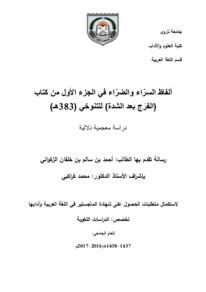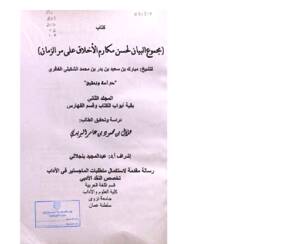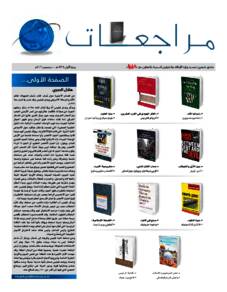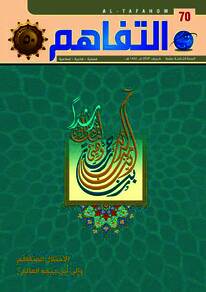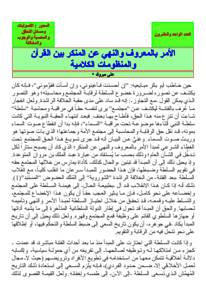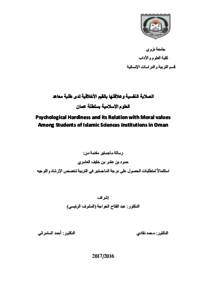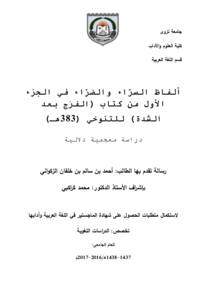Document
ألفاظ السرّاء والضرّاء في الجزء الأول من كتاب (الفرَج بعد الشدة) للتنوخي (383هـ) : دراسة معجمية دلالية.
Publisher
جامعة نزوى
Gregorian
2017
Language
Arabic
Subject
English abstract
This message studies what we call the words of optimism which impliedly refer to happiness. And the words of evils that impliedly refer to wickedness. In the first part of the book of tanokhi. 384 hejeri. Which is entitled. Calm after storm. That means good after bad. Also releasing after suffering. It contains a preface. Introduction. Three chapters and a conclusion. The consequences that the researcher got. The message is based on the two methods of analysis and decision of the above mentioned words of good and bad. For the above mentioned author who totally regards the contextual meaning of every word. by depending on Arabic dictionaries and mother books of the language. I myself try to distribute these words on the evidence fields. Through the relations of evidence among them. And I tackled with deep study the fields of theory. And the linguistic differencies among vocabularies
finally reached with my study to the following results:
1- The Arab Linguists were The first ones who dealt with the fields of evidence .that embodied their effort in what is known the message of the language and books of adjectives ,odds and phrases.
2- The words of good and words of evils assured that the Arabic language is vivid and so large and It is too rich in vocabulary of synonyms and antonymous .
3- The phrases that actually used give features of social ,political and religious textures which surrounded the author .and that also revealed his psychological sides of the feeling of the author and his senses.
-4 The religious Islamic references was his own basic source of knowledge.
-5 good and bad words implies a lot of features mentally and psychologically sides .
-6 the study of the relatios of evideces of words of good and bad shows the wealth of such evidences .
Member of
Resource URL
Arabic abstract
تدرس هذه الرسالة ألفاظ السراء، والضراء في الجزء الأول من كتاب الفرج بعد الشدة للتنوخي ( 384 هـ), وتتكون هذه الدراسة من مقدمة، وتمهيد، وثلاثة فصول، وخاتمة تتضمن أهم النتائج التي توصل إليها الباحث, واعتمدت في هذه الدراسة المنهج الوصفي، ويعضده التحليل, والتفسير, والتعليل, والإحصاء, مراعيا في ذلك سياقات المفردات, واستعنت في هذا العمل بالمعجمات العربية، وكتب اللغة, وحاولت توزيع المفردات على حقول دلالية, وذلك من خلال العلاقات الدلالية بينها, وقد بينت في هذه الدراسة أيضا المعالم الكبرى لنظريتي الحقول الدلالية, والسياقية, وكذا الفروق اللغوية بين المفردات.
ومن النتائج التي أسوقها على سبيل الذكر لا الحصر ما يأتي:
1- لقد كان للغويين العرب السبق في مجال الحقول الدلالية, وقد تمثلت جهودهم فيما يعرف بالرسائل اللغوية, وكتب الصفات, والغريب, والألفاظ.
2- أكَّدت ألفاظ السراء، والضراء الكثيرة مدى سعة اللغة العربية, وغناها بالمترادفات, والمتقابلات.
3- أعطت الألفاظ المستخدمة ملامح من النسيج الاجتماعي، والسياسي، والديني الذي كان يحيط بالمؤلف, وكذا أظهرت بعض الجوانب النفسية لشخصية المؤلف، وأحاسيسه.
4- الملمح الديني الإسلامي كان حاضرا في الألفاظ المعالجة في البحث, وهذا مرجعه إلى النشأة التي نشأ فيها المؤلف.
5- تتضمن ألفاظ السراء, والضراء جوانب متعددة مادية, ومعنوية, وغيرها.
6- كشفت دراسة العلاقات الدلالية بين ألفاظ السراء، والضراء عن ثراء معجمي، ودلالي.
ومن النتائج التي أسوقها على سبيل الذكر لا الحصر ما يأتي:
1- لقد كان للغويين العرب السبق في مجال الحقول الدلالية, وقد تمثلت جهودهم فيما يعرف بالرسائل اللغوية, وكتب الصفات, والغريب, والألفاظ.
2- أكَّدت ألفاظ السراء، والضراء الكثيرة مدى سعة اللغة العربية, وغناها بالمترادفات, والمتقابلات.
3- أعطت الألفاظ المستخدمة ملامح من النسيج الاجتماعي، والسياسي، والديني الذي كان يحيط بالمؤلف, وكذا أظهرت بعض الجوانب النفسية لشخصية المؤلف، وأحاسيسه.
4- الملمح الديني الإسلامي كان حاضرا في الألفاظ المعالجة في البحث, وهذا مرجعه إلى النشأة التي نشأ فيها المؤلف.
5- تتضمن ألفاظ السراء, والضراء جوانب متعددة مادية, ومعنوية, وغيرها.
6- كشفت دراسة العلاقات الدلالية بين ألفاظ السراء، والضراء عن ثراء معجمي، ودلالي.
Category
Theses and Dissertations

